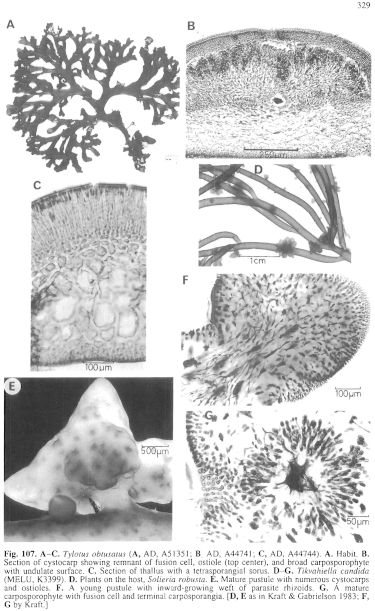|
|
|
|
|
|||||||||||
|
Electronic Flora of South Australia Species Fact Sheet
Phylum Rhodophyta – Class Florideophyceae – Order Gigartinales – Family Dicranemataceae
Selected citations: Kraft 1977b: 245, figs 10,11,19,20.
Synonym
Chondrus obtusatus Sonder 1845: 56.
Thallus (Fig. 107A) dark red-brown, fading to yellow-brown, cartilaginous, 5–15 cm long and more or less decumbent, irregularly subdichotomously and complanately branched with occasional marginal proliferations, branches 5–12 mm broad and 200–400 µm thick; basal 2–3 cm prostrate, attached by stout, terete, simple haptera (Fig. 106H) 2–15 mm long; epilithic. Structure pseudoparenchymatous (Fig. 106I) without a differentiated medulla, inner cells ovoid, 40–60 (–80) µm in diameter, decreasing in size to the outer cortex with the surface cells radially elongate, 4–6 µm in diameter. Rhodoplasts discoid, several per cell.
Reproduction: Sexual thalli monoecious, with female gametangia on the under surface (Fig. 106H) and male on the upper surface of branches; procarpic. Carpogonial branches (Fig. 106J) 3-celled, scattered in the outer cortex, laterally attached and reflexed with the adjacent cortex developing into anticlinal filaments. Supporting cell acting as the auxiliary cell (Fig. 106J), forming a large fusion cell (Fig. 106K) and a reticulum of gonimoblast filaments and vegetative cells from which outer cells cut off single, subspherical to ovoid, carposporangia (Fig. 106L) 4–8 µm in diameter, with the surface of the carposporophyte (Fig. 107B) becoming markedly undulate. Pericarp thick, derived from anticlinal filaments of the outer cortex, ostiolate. Cystocarps broadly domed, 1–2 mm across, basally constricted, scattered across the lower surface of fronds. Spermatangia (Fig. 106M) in small sunken clusters developed from cortical cells on the upper surface of fronds, ovoid, 2–3 µm in diameter.
Tetrasporangial nemathecia (Fig. 107C) swollen, 10–20 mm long and 2–6 mm broad, on the upper surface of fronds within a few centimetres of apices. Tetrasporangia (Fig. 106N) in the surface layer and also buried deeper in old nemathecia when sterile paraphyses continue growth, laterally basally attached, elongate-ovoid to clavate, 25–35 µm long and 7–10 µm in diameter, zonately divided.
Type from W. Aust. (Preiss); lectotype (Geographe Bay, W. Aust.) in Herb. Sonder, MEL, 44500.
Selected specimens: 7 mile beach, N of Dongara, W. Aust., drift (Womersley, 17.ix.1979; AD, A51351). Port Denison, W. Aust., drift (Kraft 4156, 14.xii.1971; AD, A41823). Point Clune, Rottnest I., W. Aust., 13–14 m deep (Walker, 6.xii.1984; AD, A56639). Miami Beach, Mandurah, W. Aust., drift (Kraft 1602, 9.vi.1966; AD, A44741). Hamelin Bay, W. Aust., 5–6 m deep (Kraft & Ricker, 13.viii.1979; MELU, A39577). Elliston, S. Aust., 10 m deep in bay (Shepherd, 18.iv.1970; AD, A35856). Reef between Hopkins and Thistle Islands, S. Aust., 6–10 m deep (Baldock, 1.i.1964; AD, A27143). Aldinga, S. Aust., 2–3 m deep (Kraft 4360, 7.xii,1972; AD, A44742). Vivonne Bay, Kangaroo I., S. Aust., drift (Womersley, 19.xii.1990; AD, A60823). Cape Lannes, S. Aust., 0.5 m deep in shaded pool (Kraft, 14.v.1972; AD, A44744). Nora Creina, S. Aust., 5–6 m deep (R. Lewis & Kraft, 13.v.1972; AD, A42228). Point Roadknight, Vic. (Davis, 1.ii.1946; AD, A15527). Point Lonsdale, Vic., 3 m deep (Kraft, 14.ii.1977; MELU, A39580/84). Inverloch, Vic., 2–3 m deep (Kraft & J. Lewis, 17.x.1975; MELU, A39578).
Distribution: Champion Bay, W. Aust. to Inverloch, Vic.
Taxonomic notes: Tylotus obtusatus is characterised by habit, prostrate base attached by haptera, absence of a differentiated medulla, and separation of male and female structures to opposite sides of the branches. It is more commonly found on West Australian coasts but occurs, in moderately deep water, as far east as Western Port, Victoria.
The record of Norris (1986) of T. obtusatus from Natal, South Africa, is of a plant with marginal cystocarps (which lack ostioles) arising on the upper surface, and spermatangia cut off from surface cortical cells on either side of the thallus. These features appear to exclude the Natal plant from Tylotus, possibly also from the Dicranemataceae.
References:
AGARDH, J.G. (1876). Species Genera et Ordines Algarum. Vol. 3, Part 1 - Epicrisis systematis Floridearum, pp. i-vii, 1–724. (Weigel: Leipzig.)
AGARDH, J.G. (1879). Florideernes morphologi. K. Svenska Vetensk. Akad. Handl. 15(6), 1–199, Plates 1–33.
KRAFT, G.T. (1977b). Studies of marine algae in the lesser-known families of the Gigartinales (Rhodophyta). H. The Dicranemaceae. Aust. J. Bot. 25, 219–267.
NORRIS, R.E. (1986). Tylotus (Gigartinales, Rhodophyceae), a genus known in Australia and Japan, newly recorded in South Africa. Jap. J. Phycol. 34, 282–286.
SONDER, O.G. (1845). Nova Algarum genera et species, quas in itinere ad oras occidentales Novae Hollandiae, collegit L. Preiss, Ph.Dr. Bot. Zeit. 3, 49–57.
The Marine Benthic Flora of Southern Australia Part IIIA complete list of references.
Publication:
Womersley, H.B.S. (14 January, 1994)
The Marine Benthic Flora of Southern Australia
Rhodophyta. Part IIIA, Bangiophyceae and Florideophyceae (to Gigartinales)
Reproduced with permission from The Marine Benthic Flora of Southern Australia Part IIIA 1994, by H.B.S. Womersley. Australian Biological Resources Study, Canberra. Copyright Commonwealth of Australia.
Illustration in Womersley Part IIIA, 1994: FIGS 10611-N, 107 A–C.

Figure 107 enlarge
Fig. 107. A–C. Tylotus obtusatus (A, AD, A51351; B, AD, A44741; C, AD, A44744). A. Habit. B. Section of cystocarp showing remnant of fusion cell, ostiole (top center), and broad carposporophyte with undulate surface. C. Section of thallus with a tetrasporangial sorus. D–G. Tikvahiella candida (MELU, K3399). D. Plants on the host, Solieria robusta. E. Mature pustule with numerous cystocarps and ostioles. F. A young pustule with inward-growing weft of parasite rhizoids. G. A mature carposporophyte with fusion cell and terminal carposporangia. [D, E as in Kraft & Gabrielson 1983; F, G by Kraft.]

|
Email Contact: State Herbarium of South Australia |

|